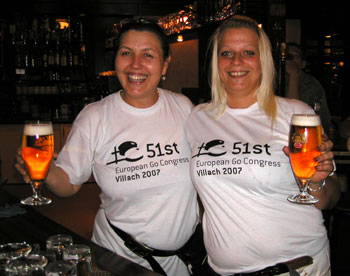
July 20, 2007; Volume 8, #52
GO CAMPERS IN ACTION
18 PROS TO ATTEND U.S. CONGRESS
GOT QUARK? WAY TO GO!
AGA CONSIDERS ISSUING RANK CERTIFICATES
WORLD GO NEWS: Lee Changho Holds Off Yun In Wangwi
EUROPEAN GO CONGRESS SPECIAL REPORT
Euro Congress Tourney Update; Czechs Master Small Board; Taking It To The Streets; Stump The Pro; Pietsch Legacy Nurturing New Generation;
A (Very) Short History Of Go In Europe (Part 1); In The Strong Player’s Room; Friends Don’t Mind When Friends Get Stronger; A Stone Too Far; Rosetta Stones
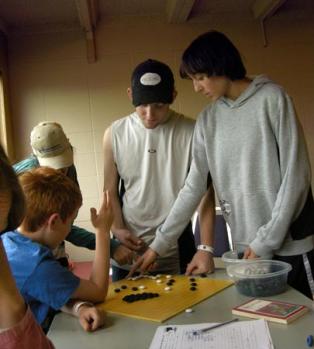
GO CAMPERS IN ACTION: With six hours of instruction and practice each day in one of four classes, West Coast go campers have had plenty to think about this week; here (photo at left) they work on solving problems. Favorite afternoon games have included Capture the Ball, and Ultimate Frisbee. In the evening, campers often found more time for go. Camp finishes up on Saturday.
- report/photos by Brian Allen
GOT QUARK? WAY TO GO! The American Go Foundation is looking for a volunteer to help update the classic "The Way To Go." With more than 40,000 copies in circulation, the little 48-page booklet is due for its seventh printing, and updating, as well. "The perfect volunteer is someone with skills and access to Quark Express and who will be at the Go Congress, so we could complete the update right there," says AGF President Terry Benson. "But we'll be happy to work with anyone who can help us update this terrific resource.” Those interested can contact Benson at agf@usgo.org
AGA CONSIDERS ISSUING RANK CERTIFICATES: Should the American Go Association
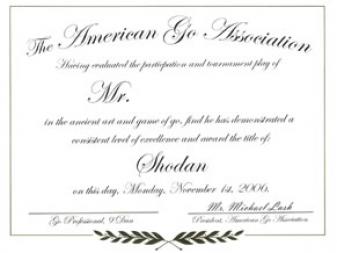 (AGA) begin issuing rank certificates? The
AGA Board of Directors is considering a proposal from the Rank
Certification Committee to implement a rank certification program
honoring members for significant achievement in playing strength. Click
here to let us know what you think. Your responses will help
the Board and the Committee decide whether to proceed with this
proposal and if so, what approach members would find most favorable. In
contrast to other cost-based certification programs, where actual playing
strength is irrelevant, the AGA program would be strictly merit-based.
Players would have to earn their honors on the go board. The proposal
envisions that an AGA official would certify that the player has
performed at the required level for a required amount of time and
number of games and the certificate could then be validated by a
professional player. The proposed program would not affect current
rating or placement in tournaments. All players in AGA rated
tournaments would continue to receive ratings expressed in rank
equivalents on the AGA ratings page as they do now. The goal is to
offer players an attractive, highly respected recognition of their
achievement. "This survey will be open for responses for one week,"
says AGA Board Chairman Roy Laird. "The Committee and Board will then
close it and study the results, so please respond
now to make your opinions heard!"
(AGA) begin issuing rank certificates? The
AGA Board of Directors is considering a proposal from the Rank
Certification Committee to implement a rank certification program
honoring members for significant achievement in playing strength. Click
here to let us know what you think. Your responses will help
the Board and the Committee decide whether to proceed with this
proposal and if so, what approach members would find most favorable. In
contrast to other cost-based certification programs, where actual playing
strength is irrelevant, the AGA program would be strictly merit-based.
Players would have to earn their honors on the go board. The proposal
envisions that an AGA official would certify that the player has
performed at the required level for a required amount of time and
number of games and the certificate could then be validated by a
professional player. The proposed program would not affect current
rating or placement in tournaments. All players in AGA rated
tournaments would continue to receive ratings expressed in rank
equivalents on the AGA ratings page as they do now. The goal is to
offer players an attractive, highly respected recognition of their
achievement. "This survey will be open for responses for one week,"
says AGA Board Chairman Roy Laird. "The Committee and Board will then
close it and study the results, so please respond
now to make your opinions heard!"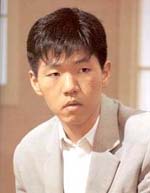
WORLD GO NEWS
LEE CHANGHO HOLDS OFF YUN IN WANGWI: Lee Changho 9P defeated tenacious teenager Yun Junsang 6P on Wednesday, July 18th, in the final game of their best-of-five-game match for Lee's Korean Wangwi title to claim the title for the twelfth consecutive year by a score of 3-2. Earlier this year, Yun defeated Lee to take the Korean Kuksu title by a score of 3-1. In the Wangwi title match, Lee won the second and fourth games by a half point and 1.5 points respectively, but he finally forced a resignation in game five. The only other title Lee holds at the moment is the Korean Myeongin, which he has also held twelve times, though he lost it to Cho Hunhyun 9P in 1997.
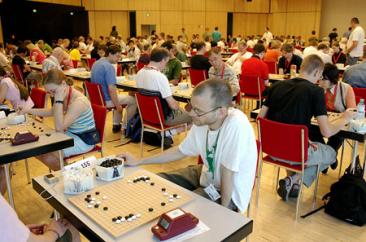
EUROPEAN GO CONGRESS SPECIAL REPORT
E-Journal Managing Editor Chris Garlock has been filing reports online this week from the 51st European Go Congress in Villach, Austria. As part of the EGC communications team, he’s also been coordinating live broadcast of top-board games on IGS, which are posted online The team – which includes EGC Bulletin Editor-in-Chief Peter Dijkema, videographer Harry Weerheijm, photographer Martin Chrz, graphic designer (and game recorder) Thomas Weniger and game recorders Hu Bin and Ron Polak, has been publishing regular print reports for EGC attendees, posting videos and photos Check the main AGA website and the news page for all the reports (use the arrows to scroll back day by day). Unless otherwise noted, the reports below are by Garlock. Photo, top right: barmaids at a pub popular with Congress attendees offer a highly-favored local beverage; photo by Chris Garlock. Photo, right: American Russ Williams (now living in Poland) in the main Congress playing area; photo by Martin Chrz.
EURO CONGRESS TOURNEY UPDATE: The main 10-round European Go Congress Open Championship tournament started off Sunday with 231 boards; while more than 700 have registered, some come for the first week, some for the 2-day 5-round weekend tournament between weeks 1 and 2 and some for the second week. The top 16 boards – also known as the “Supergroup” – plays in a separate room with Japanese rules, while everybody else plays by Ing rules. The Supergroup was enlarged to 34 players this year when the European Go Federation (EGF) added two 'wild-card' players. Who gets into this top group -- and who doesn’t -- is a delicate and complicated matter. While the EGF needs to ensure a minimum number of Europeans in the Supergroup, it also wants to encourage up-and-coming new young talents, and of course Asians resident in Europe are among the strongest players on the continent. The EGC championship often has two winners: the outright winner, who collects the cash prize, and the top European player, who wins the European Champion title. One of the Supergroup requirements is that the players must participate in all ten rounds. All of which helps to explain why a few nominal 8-dans from Korea did not make the Supergroup cut. Click here for latest results in the main tournament, or here for the Rapid Tournament results. NOTE: watch for LIVE broadcast of top boards tomorrow (Saturday) on IGS starting at 10A Central. See attached for two game records, plus all top board games are posted online
– reported by Peter Dijkema
CZECHS MASTER SMALL BOARD: Bronislav Snidal 1d (CZ) won the EGC 13x13 tournament event Wednesday, with fellow countryman Ondra Kruml 2d (CZ) taking second place, making the Czechs the undisputed masters of the small board. Antti Törmanen 4d (FI) was undefeated and might have won the 6-round tournament – played with handicaps -- if he hadn’t missed the first round. A total of five players – Snida
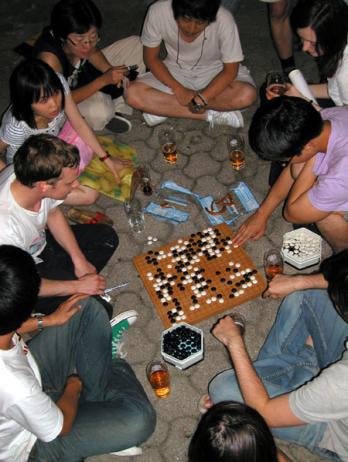 l, Kruml,
Cherbakov 5d (RU), Butala 4d (SI) and Tormanen -- wound up with
identical scores with the results decided on SOS. - reported
by Ron Polak
l, Kruml,
Cherbakov 5d (RU), Butala 4d (SI) and Tormanen -- wound up with
identical scores with the results decided on SOS. - reported
by Ron PolakTAKING IT TO THE STREETS: This year’s European Go Congress is being held in Villach’s convention center, instead of the customary university campus (as in the United States). This means that players are on their own for meals, which can be a bit disconcerting, but provides a very pleasant and relaxed feel as each day unfolds unhurriedly. The main tournament game of the day begins at a very civilized 10A, although even that’s apparently too early for some players, undoubtedly the same ones availing themselves of the opportunity to play late into the night at the local cafes. With lunch breaks optional, many players continue right through until the end, after which they repair to the center’s restaurant/bar downstairs, where they can eat, drink and smoke as they replay their games. The choice of such a public space for the Congress was intentional, organizer Simon Gemel told the EJ. “We wanted to draw greater public attention to the Congress and to help build interest in Austrian go,” Gemel said, adding that free public go lessons are offered daily at 11A. The strategy has paid off well, drawing newspaper, radio and TV coverage in the Austrian media, along with public exposure to the game as hundreds of go players disperse into the town’s cafes, restaurants and shops each day. Photo, right: Top players and friends relax outside a popular pub Thursday night; photo by Chris Garlock
PIETSCH LEGACY NURTURING NEW GENERATION: “The best teachers don’t teach,”
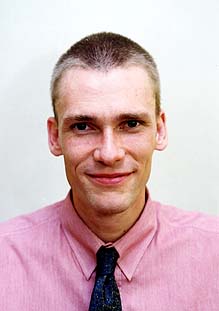 Harald Kroll said. That his
words had multiple levels of meaning is appropriate, given
Kroll’s occupation as a translator. Kroll, a German, founded
the Hans Pietsch Memorial School in 2004, after Pietsch, a 4-dan German
professional on a promotional go tour for the Nihon Ki-in in Guatemala,
was murdered in 2003. But it’s not just that Pietsch does not
teach at the school named after him; even the instructors
don’t teach, at least not in the
traditional manner. “They just play,” Kroll told
the EJ over lunch on Thursday. Krall learned to play in an Italian
café some years ago when two regular players there taught
him. “Later, this Japanese player started showing up who
turned out to be 4 dan but he was very quiet about his strength, just
played.” The Pietsch Memorial School focuses on recruiting
and training young go players in Germany, some as young as six,
providing equipment and travel expenses. Last year the school took
students to a dozen events at a total cost of over five thousand Euros.
Yuki Shigeno is one of three pros on the school’s board; the
other two are Hideki Enda and Kim Hyo Jung. One of few Western go
professionals, Hans Pietsch moved to Japan in 1990 and became a
disciple of Kobayashi Satoru. He became a 1-dan professional with the
Nihon Ki-in in 1997, the same year he beat Yoda Norimoto by half a
point in the first round of the 1st LG Cup. Promoted to 4-dan in 2000,
he was posthumously promoted to 6-dan by the Nihon Ki-in on January
21st, 2003 “for his great contributions to the worldwide
promotion of go” and also won the 36th Kido International
Award. Over 70 go supporters contribute to the school; click
here to find out more about it or email Kroll at
info@go4school.de
Harald Kroll said. That his
words had multiple levels of meaning is appropriate, given
Kroll’s occupation as a translator. Kroll, a German, founded
the Hans Pietsch Memorial School in 2004, after Pietsch, a 4-dan German
professional on a promotional go tour for the Nihon Ki-in in Guatemala,
was murdered in 2003. But it’s not just that Pietsch does not
teach at the school named after him; even the instructors
don’t teach, at least not in the
traditional manner. “They just play,” Kroll told
the EJ over lunch on Thursday. Krall learned to play in an Italian
café some years ago when two regular players there taught
him. “Later, this Japanese player started showing up who
turned out to be 4 dan but he was very quiet about his strength, just
played.” The Pietsch Memorial School focuses on recruiting
and training young go players in Germany, some as young as six,
providing equipment and travel expenses. Last year the school took
students to a dozen events at a total cost of over five thousand Euros.
Yuki Shigeno is one of three pros on the school’s board; the
other two are Hideki Enda and Kim Hyo Jung. One of few Western go
professionals, Hans Pietsch moved to Japan in 1990 and became a
disciple of Kobayashi Satoru. He became a 1-dan professional with the
Nihon Ki-in in 1997, the same year he beat Yoda Norimoto by half a
point in the first round of the 1st LG Cup. Promoted to 4-dan in 2000,
he was posthumously promoted to 6-dan by the Nihon Ki-in on January
21st, 2003 “for his great contributions to the worldwide
promotion of go” and also won the 36th Kido International
Award. Over 70 go supporters contribute to the school; click
here to find out more about it or email Kroll at
info@go4school.dePROFESSIONALLY SPEAKING: Stump The Pro & How To Lose
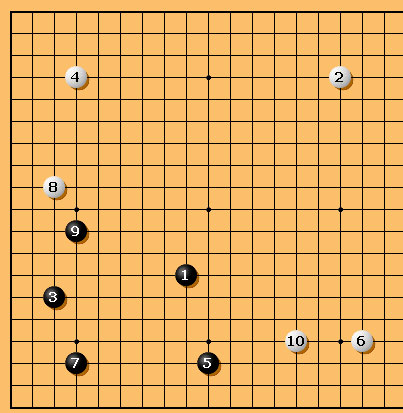
Stump The Pro: “I have nothing to say about this game,” the pro announced. “I have no idea if it’s good or bad. I just don’t know.” Robert Jasiek 5d of Germany played the unusual opening (at right) in his second-round game against Vesa Laattikainen 5d of Finland. The game – which Jasiek lost – is attached.
How To Lose: “There are many ways to lose games,” said Kobayashi Chizu 5P, the Nihon Kiin pro on a year-long assignment to teach go in Austria. “Everybody's going to lose, but you must try to learn something from each loss.” Kobayashi commented a Round 4 game (attached) between Matti Siivola 5d of Finland and Ui Hong-Seok of Korea. “This way of losing is the hardest. White tried to use his power against a strong player; this is the fastest way to lose. As in aikido, you must use your opponent's power against them.”
A (VERY) SHORT HISTORY OF GO IN EUROPE (Part 1): With well over 700 players from virtually every European country participating in the 51st annual European Go Congress it’s obvious that go is widespread here. There are go clubs in cities, towns and villages across the
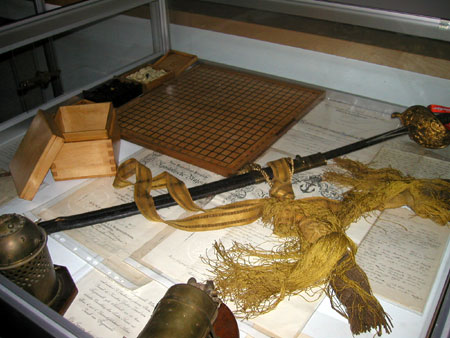 continent, as
well as an active calendar of events and tournaments. While
it’s likely that the Portuguese – who first made
contact with Japan nearly 500 years ago – were the first
Europeans to learn go, the roots of the game go deepest in the
Netherlands, “the only Europeans allowed to enter the
Japanese territory for a couple of centuries,” reports Franco
Pratesi in his invaluable EuroGo Vol. 1 (Arachne, 2004). In 1669
Arnoldus Montanus published an extensive description of Japan that
includes two references to go, “in both cases as a usual
occupation of Japanese guards,” including an illustration
showing two players at a goban with two kibitzers watching.
“A fundamental question is to define the place and time of
the starting point for go being played correctly in Europe,”
writes Pratesi. But like so much in European history – in all
history, for that matter – specifics are difficult to nail
down. What is clear is that the game came to Europe as merchants,
missionaries, travelers and scientists moved back and forth between
Europe and Asia. First came descriptions of a strange new game, then a
few sets and books in Chinese and Japanese. Pratesi identifies two main
lines of transmission, the first from China to England, the other from
Japan to Germany. In neither case, however, did go spark a game craze,
as had some other board games, remaining primarily a local phenomenon
“within a few family circles.” but it
doesn’t really take root until the latter half of the 1800s
in Germany. The Johnny Appleseed of European go was Oskar Korshelt, who
spent ten years in Japan from 1876-1886 and who learned the game there
during a long illness. (TO BE CONTINUED) Photo of an EGC
exhibition of go-related materials from the collection of Arthur Jonak,
a naval officer in the Austrian monarchy who founded the first known go
club in Europe; photo by Chris Garlock.
continent, as
well as an active calendar of events and tournaments. While
it’s likely that the Portuguese – who first made
contact with Japan nearly 500 years ago – were the first
Europeans to learn go, the roots of the game go deepest in the
Netherlands, “the only Europeans allowed to enter the
Japanese territory for a couple of centuries,” reports Franco
Pratesi in his invaluable EuroGo Vol. 1 (Arachne, 2004). In 1669
Arnoldus Montanus published an extensive description of Japan that
includes two references to go, “in both cases as a usual
occupation of Japanese guards,” including an illustration
showing two players at a goban with two kibitzers watching.
“A fundamental question is to define the place and time of
the starting point for go being played correctly in Europe,”
writes Pratesi. But like so much in European history – in all
history, for that matter – specifics are difficult to nail
down. What is clear is that the game came to Europe as merchants,
missionaries, travelers and scientists moved back and forth between
Europe and Asia. First came descriptions of a strange new game, then a
few sets and books in Chinese and Japanese. Pratesi identifies two main
lines of transmission, the first from China to England, the other from
Japan to Germany. In neither case, however, did go spark a game craze,
as had some other board games, remaining primarily a local phenomenon
“within a few family circles.” but it
doesn’t really take root until the latter half of the 1800s
in Germany. The Johnny Appleseed of European go was Oskar Korshelt, who
spent ten years in Japan from 1876-1886 and who learned the game there
during a long illness. (TO BE CONTINUED) Photo of an EGC
exhibition of go-related materials from the collection of Arthur Jonak,
a naval officer in the Austrian monarchy who founded the first known go
club in Europe; photo by Chris Garlock.IN THE STRONG PLAYER’S ROOM: In stark contrast to the cheerful hubbub of the main playing area each morning as hundreds of players mill about, the strong player’s room is not only quiet, it’s empty until the round begins at 10A, except for the young Lithuanian players in their green team t-shirts who come in just before then to set all the clocks and neatly place the bowls on each board. Promptly at 10, as if by magic, all the strong players appear, sit down at their boards and, without prompting or preliminaries, begin playing. Players get two and a half hours each and lunch breaks are optional by agreement between the players, and many of them don’t bother to stop, playing through, often until mid-afternoon. As the games end, players usually quietly review a couple of key points and then leave the room, which by late afternoon, is once agai
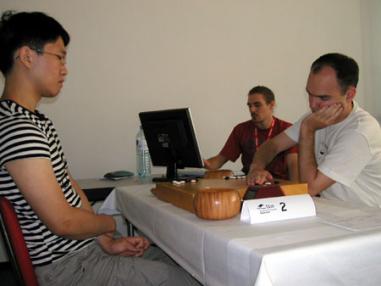 n empty
and still, as though all the mayhem on the sixteen boards had never
happened. It’s been a real treat to get to meet the people
behind some of the top names in European go this week. Familiar names
like Alexander Dinershteyn 1P of Russia and Antoine Fenech 5d of
France, both of whom are regular contributors to the EJ, as is
Romania’s Cornel Burzo 6d. Then there’s
Burzo’s countryman Cristian Gabriel Pop 7d, as well as Csaba Mero 6d
and Pal Balogh 6d of Hungary, Czechs Vladimir Danek 5d and Ondrej Silt
6d, who I last saw in Tokyo at the World Amateur Championships with his
girlfriend – and Pair Go partner -- Rita Pocsai 4d of Hungary
(who’s here as well). Russians Illya Shiksin 6d (whose
sister, 2006 European Champion Svetlana Shiksina 1P, passed up the
chance to defend her title this year to give birth on July 1 to her son
Vyacheslav) and Andrej Kulkov 6d are here, as is Benjamin Papazoglou 5d
of France and Gert Schnider of Austria. There are many more, of course,
whose names are not yet widely known and who we can look forward to
following in the months and years to come.
Photo of Alexander Dinershteyn 8d (r) & Cho Seok-bin 7d in the
2nd round; photo by Chris Garlock
n empty
and still, as though all the mayhem on the sixteen boards had never
happened. It’s been a real treat to get to meet the people
behind some of the top names in European go this week. Familiar names
like Alexander Dinershteyn 1P of Russia and Antoine Fenech 5d of
France, both of whom are regular contributors to the EJ, as is
Romania’s Cornel Burzo 6d. Then there’s
Burzo’s countryman Cristian Gabriel Pop 7d, as well as Csaba Mero 6d
and Pal Balogh 6d of Hungary, Czechs Vladimir Danek 5d and Ondrej Silt
6d, who I last saw in Tokyo at the World Amateur Championships with his
girlfriend – and Pair Go partner -- Rita Pocsai 4d of Hungary
(who’s here as well). Russians Illya Shiksin 6d (whose
sister, 2006 European Champion Svetlana Shiksina 1P, passed up the
chance to defend her title this year to give birth on July 1 to her son
Vyacheslav) and Andrej Kulkov 6d are here, as is Benjamin Papazoglou 5d
of France and Gert Schnider of Austria. There are many more, of course,
whose names are not yet widely known and who we can look forward to
following in the months and years to come.
Photo of Alexander Dinershteyn 8d (r) & Cho Seok-bin 7d in the
2nd round; photo by Chris Garlock